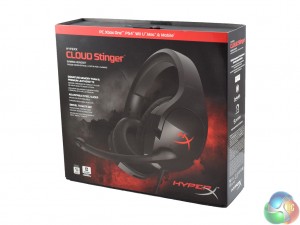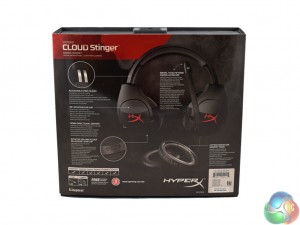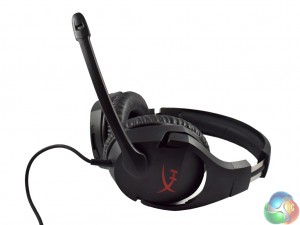
In an increasingly saturated peripheral market, HyperX are hoping their new Cloud Stinger can become the ‘go-to' headset if you are on a budget. Priced at £49.99, it comes in cheaper than the acclaimed Cloud and Cloud II headsets while keeping familiar features from those devices, including memory foam ear pads and a flexible boom mic. With its svelte, matte-black finish, the Cloud Stinger is also an attractive piece of kit – but how good is it? Let's find out.
HyperX have built up a great reputation for quality headsets over the last few years, thanks to their Cloud and Cloud II devices. Those headsets are towards the pricier end of the spectrum, though, so HyperX hope the new Cloud Stinger will appeal to the mass-market in a way those premium headsets cannot manage to do. However, we would still expect good quality for £49.99, so let's dive right into the review – where we look at build quality, practicality and audio performance before giving a final verdict.
Specification
Headset:
- Driver: Dynamic, 50mm with neodymium magnets
- Type: Circumaural, Closed back
- Frequency response: 18Hz-23,000Hz
- Impedance: 30 Ω
- Sound pressure level
- : 102 ± 3dBSPL/mW at 1kHz
- T.H.D.: < 2%
- Input power: Rated 30mW, Maximum 500mW
- Weight: 275g
- Cable length and type: Headset (1.3m) + Extension Y-cable(1.7m)
- Connection: Headset – 3.5mm plug (4 pole) + extension cable – 3.5mm stereo and mic plugs
Microphone:
- Element: Electret condenser microphone
- Polar pattern: Uni-directional, Noise-canceling
- Frequency response: 50Hz~18,000Hz
- Sensitivity: -40 dBV (0dB=1V/Pa,1kHz)
The HyperX Cloud Stinger ships in a red-and-black box with a large product photo on the front. The back of the box highlights a few key features of the headset, which we shall look at ourselves in this review.
Upon opening the box, it is clear that the headset comes well protected by a lot of padding. Even though the Cloud Stinger is a cheaper device, HyperX are still making sure it arrives safe and sound.
Also included in the box is a small quick start guide, as well as a ‘welcome to the team' greeting card from HyperX.
Getting our first look at the headset, then, it does look similar to the Cloud and Cloud II models – the HyperX logo is emblazoned across the back of each ear cup, while the red-and-black theme remains as well.
That being said, the Cloud Stinger is a cheaper device and lacks the premium feel of its more expensive siblings. This is made clear by the plastic construction – the ear cups are not made of the sternest stuff, while the brushed aluminium finish that is present on the ear cups of the Cloud and Cloud II is also gone. Obviously for a £50 headset you cannot expect the best build quality, but I would be careful to not bash the Cloud Stinger around too much.
One new feature, though, is the rotating ear cups, demonstrated by the image on the right. This is helpful when travelling with the headset as it means the device can lie (reasonably) flat.
The headband is another area where the Cloud Stinger deviates from its older siblings' design. The Cloud and Cloud II both feature entirely padded headbands – the Stinger, however, is made with just a strip of padding on the underside of the headband, while the outer shell is plastic. There is also some ‘HyperX' branding on the top of the headband.
While the headband is mostly plastic, the frame makes uses of a steel slider if you want to adjust the headband size. I found the Cloud Stinger fits with plenty of room to spare, so it should fit pretty much anybody.
The ear cups themselves are circumaural, meaning they cover the whole of your ear. The cups also sport memory foam padding – something which is to be found in all of HyperX's headsets. This should make wearing the headset for prolonged periods that bit more comfortable than regular foam.
One new feature, though, is the volume control integrated within the right ear cup. A simple slider, pushing the slider towards the back of your head turns the volume up, while pushing the slider towards the front of your head turns it down.
Speaking of new features, a rotatable mic is another nifty inclusion. It can be tucked away, completely out of sight, or moved down to your preferred position. Incidentally, flicking the mic up and out of the way will also mute it – you will hear a small click which confirms the mic has been muted.
Lastly, the audio cable is integrated within the headset, so it cannot be removed. This integrated cable is 1.3m long and uses a single combi-audio jack. However, also included is a 1.7m extender, which splits the signal into separate audio and microphone jacks. All-in-all, a total cable length of 3m should be enough for most people.To test the HyperX Cloud Stinger headset, I used it as my daily driver for a number of weeks. I used the headset in a variety of situations – playing games, listening to music and conducting phone calls. As headset reviews are very subjective, my comments below are exactly that – my own opinion.
For starters, it is worth mentioning there is no included software suite with the Cloud Stinger. For £50 we probably would not expect this anyway, but it is worth stating it before we get on to the main body of the review.
As the Cloud Stinger is a gaming headset, I think it is only right we touch upon its performance in games first – as this is what most consumers would be doing with the headset the majority of the time.
To cut to the chase, I found the overall quality of the headset very good for the money, but for £50 the headset is never going to blow any minds. HyperX make a feature of the fact they have included 50mm dynamic drivers – and bass production is very strong accordingly. Playing first-person shooters such as Doom (2016) is a rewarding experience as explosions have great depth and intensity about them, while gunfire sounds full and threatening.
While the bass is strong, though, it is not very pronouced. By this I mean in some instances, particularly when listening to a game's soundtrack, the bass can sound a little muddy, rather than punchy and rich. This is likely because, being a cheaper headset, the Cloud Stinger does not have as great a frequency response range as its more expensive siblings. In fact, the Cloud Stinger's frequency response is quoted at 18-23,000 Hz, but the Cloud II, for example, has a quoted response of 15-25,000 Hz. It is not terrible and in most cases you would not notice, but there are instances when the bass could be more detailed to better provide a satisfying listening experience.
The mid and high-end is nice and crisp though, which makes dialogue very clear. For example, I was playing The Witcher 3: Wild Hunt recently, and walking through White Orchard causes a lot of NPCs to begin talking about all sorts of different things in the game. However, I was able to pick out each different conversation and tune in on that, as dialogue is perfectly produced.
I would not use the Cloud Stinger for listening to music though, as in that situation the high-end dominates and is too sharp to be comfortable. I found this to be the case with some rock and heavy metal – the cymbals, for instance, actually hurt my ears after a while as the sound was just too sharp. Ambient soundscapes sound great though, but on the whole I would recommend a pair of headphones designed for music instead of these if you just want to listen to your music library.
In terms of comfort, I would say the Cloud Stinger is really comfy to wear. The memory foam padding on the ear cups is lovely and soft, and moulds to the shape of your ears very well. This ensures prolonged gaming sessions are unhindered by any rubbing or friction. The cushioned headband did not cause me any problems either, despite the fact that the outer shell is plastic.
I also like the on-ear volume control – it does take some getting used to, as I am accustomed to the little control box that the original Cloud headset uses. However, after a few days of reaching up and missing the slider, you get the hang of it and changing the volume becomes quick and easy. This way of doing things also reduces the cable weight as there is no need for an in-line controller, for example.
I also had a play around the boom mic to ensure that it is of high quality – and I can happily report it is very impressive. I used a number of different methods to test the mic out, including using it in-game, recording myself using my phone, as well as using it with VOIP software. It is very crisp, with very little in the way of background noise ensuring a clear transmission. There is some slight clipping if you are talking particularly loudly, but at normal and comfortable speaking volumes it is a very clear mic.The Cloud Stinger is a budget headset (at £49.99) from HyperX – the gaming peripheral manufacturer that has built up an excellent reputation in the headset sector thanks to its Cloud and Cloud II devices.
Rather than just ‘cheaping-out' when manufacturing the Cloud Stinger, HyperX used the opportunity to include a number of new features not present in the more expensive headsets of its range. My favourite of these is the on-ear volume control, which soon becomes intuitive – but does take a bit of getting used to. Another great feature is the rotating ear cups, while the standard HyperX memory foam ear cup padding remains.
The overall construction is just a bit plasticky for my liking, though. I can fully appreciate that the Cloud Stinger is built to a price and it is never going to look or feel as great as the Cloud II, for example. However, I am just a bit concerned the headset may not stand the test of time too well – particularly if you are inclined to get a bit aggressive with your peripherals when things are not going well in-game.
That being said, audio quality is great for the price. The bass is very powerful and adds depth to the gaming experience. The bass does lack a bit of refinement when compared with its more expensive counterparts, though, but this is to be expected at this price point.
The punchy mid-range and sharp high-end is great for dialogue, however – in-game speech and movies, for example, are perfectly crisp and well-balanced. Add that to the clear mic, and the headset on offer is very impressive for the price.
All-in-all, if you are a gamer on a budget, I am happy to recommend the HyperX Cloud Stinger. It offers great audio quality for the price, as well as a number of new features that I appreciate. If you can afford the extra £20-25, though, the Cloud II offers improved audio clarity and a sturdier construction.
You can buy one for £49.99 from Overclockers UK HERE.
Discuss on our Facebook page, over HERE.
Pros
- Attractively priced.
- New features are introduced such as rotating ear cups.
- Audio quality is great for the money.
- Comfy to use.
Cons
- Construction does feel a bit plasticky.
- The Cloud II offers a better all-round package for £20-25 more.
KitGuru says: If you absolutely cannot spend more than £50 on a headset, we are happy to recommend the Cloud Stinger wholeheartedly. However, if your budget can be pushed that bit further, you may thank yourself down-the-line by going for the Cloud II instead.
 KitGuru KitGuru.net – Tech News | Hardware News | Hardware Reviews | IOS | Mobile | Gaming | Graphics Cards
KitGuru KitGuru.net – Tech News | Hardware News | Hardware Reviews | IOS | Mobile | Gaming | Graphics Cards





















